#michaelsberg abbey
Explore tagged Tumblr posts
Text
👆 sorry, the blog url link couldn't get into. "ARTIFACTSMUSEUMHISTORY.BLOGSPOT.COM"
and I really curious that so I go searching for the other infos about this Germany church :
SKELETONS, ANCIENT WEAPONS AND BUBBLES: TAKE A LOOK AT THIS HAUNTING 18TH CENTURY CHAPEL ART
We can't believe the gothic beauty of the plaster work found in this German chapel
by DEVON PRESTON /OCTOBER 15TH, 2019
Photos from here. Thanks~*
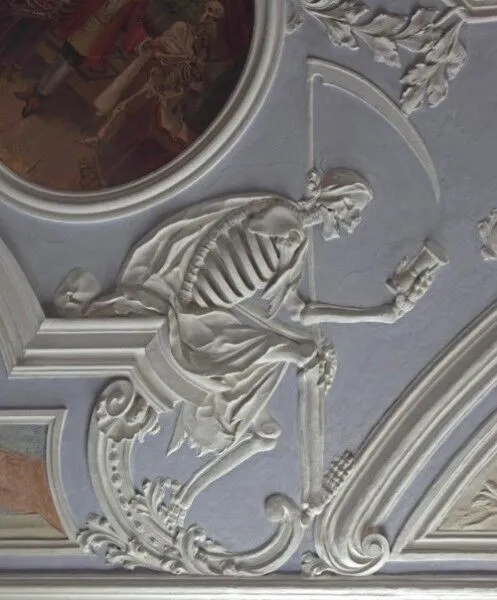






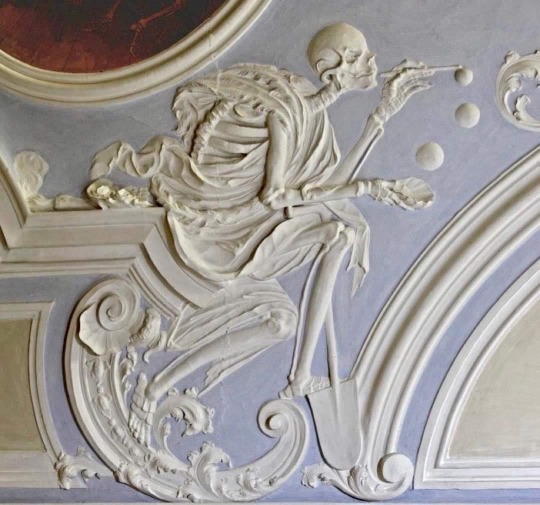
“Death blowing bubbles,” one of the several depictions of death created by Johann Georg Leinberger between 1729 and 1731 for the ceiling of the Holy Grave Chapel in Michaelsberg Abbey in Bamberg, Germany. The bubbles are symbols of the fragility of life
More: https://artifactsmuseumhistory.blogspot.com/
#@museum-of-artifacts#johann georg leinberger#georg leinberger (c.1490–1500–c.1540–1545)#german painter & woodcut artist#18th century#chapel art#gothic art#plaster work#michaelsberg abbey#bamberg#germany#death blowing bubbles#life’s fragility#the building being turned into a hospital in 1803#rococo inspired#reclaimed in 1993 as a unesco world heritage site#thank you 💗💗💗
2K notes
·
View notes
Text
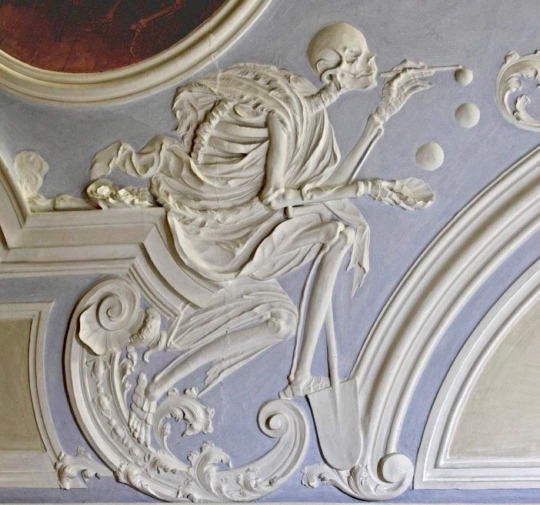
“Death blowing bubbles,” one of the several depictions of death created by Johann Georg Leinberger between 1729 and 1731 for the ceiling of the Holy Grave Chapel in Michaelsberg Abbey in Bamberg, Germany. The bubbles are symbols of the fragility of life.
2K notes
·
View notes
Text

Death Blowing Bubbles," one of several depictions of death created by Johann Georg Leinberger between
1729-1731 CE, for ceiling of Holy Grave Chapel in Michaelsberg Abbey in Bamberg, Germany.
(Bubbles are symbols of fragility of life)
#death mention tw#skeleton#skull#skull art#archaeology#history#architecture#archaeologist#history facts#history nerd#chapel#grave#holy#germany#death#grim reaper#ceiling#art history#1700s#1700s art#skeletons#whimsigothic#renaissance#sculpture#chapel art#carving#carved#historical#art facts#bubbles
98 notes
·
View notes
Text

“Death blowing bubbles,” 18th century. The bubbles symbolize life’s fragility. This plaster work appears on the ceiling of Holy Grave Chapel in Michaelsberg Abbey, Bamberg, Germany.
* * * *
I was chilled to the bone this afternoon at King Lear, when this line was spoken: “ ‘Tis the time’s plague, when madmen lead the blind.”
34 notes
·
View notes
Text

death blowing bubbles *is* an absolute classic
Had the weirdest and most sinister dream last night
#but uh what. thats so spooky scary#(this is from the celling of the Michaelsberg Abbey is Bamberg Germany in case u haven't seen it before)#i hope you have seen it before bc otherwise thats so much scarier 2 me
80 notes
·
View notes
Text
SET SEVEN - ROUND ONE - MATCH SIX
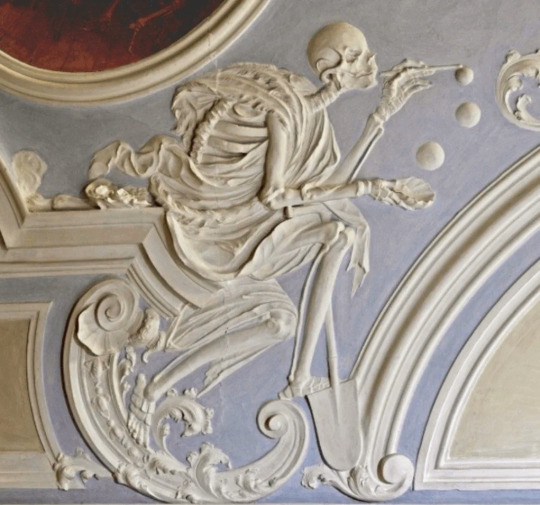

"Death Blowing Bubbles" (c.1729-1731 - Johann Georg Leinberger) / "The Kitchen Table Series" (1990 - Carrie Mae Weems)
DEATH BLOWING BUBBLES: i am so mad that if i want to rub my hands all over this piece, i have to go to germany. i just KNOW that this carving feels amazing running your hands along it. i love this piece though, the shovel propped up at its feet makes me think this is death after a day's work just sitting down and unwinding, same as anyone else. maybe it's sitting up on a rooftop, letting the bubbles drift up to the sky and watching them float above the city. i like that idea of death.
THE KITCHEN TABLE SERIES: [no additional commentary] (@gaysheep)
("Death Blowing Bubbles" refers to plaster work found in the Holy Grave Chapel, Michaelsberg Abbey, located in Bamberg, Germany. The chapel was decorated by Johann Georg Leinberger from 1729 to 1731.
"The Kitchen Table series" is a series of 20 photographs by Carrie Mae Weems, meant to depict a play which highlights Weem's many roles in her life. Each image is 50.8 × 50.8 cm (20 × 20 in.). )
135 notes
·
View notes
Text

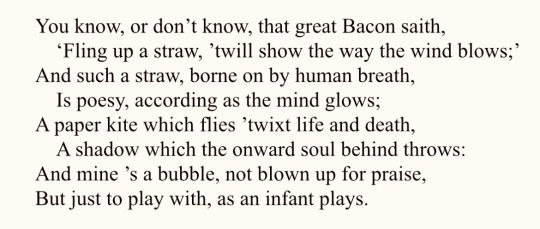
— Plaster relief on the ceiling of the Holy Grave Chapel in Michaelsberg Abbey, Bamberg, Germany / Lord Byron's Don Juan, Canto 14, stanza 8
#psa everyone shld read canto 14 of don juan pls#lord byron#don juan#skeleton#bubbles#aesthetic#dark academia#etc#poetry#gothic#goth#quotes#death#life#writing#poets#plaster relief#plaster#sculpture#art#beauty#web weaving#literature
47 notes
·
View notes
Text
Abandoned Project: Old Ink For New Ink
Last year in the midst of waiting to hear back on whether I was going to get the funding to do the project that has now consumed my every waking hour, I came up with a fun little project. I never DID the project because of the aforementioned thing that now occupies all my time. But I thought others might find the idea fun:
My friend and I called it "Old Ink For New Ink" and it was basically an Instagram/Tumblr account that reposted cool old art that we think would make for good tattoos. This kind of exists in a few places but the key thing that we wanted to do to make ours different was to actually include a bunch of information about the history of the image, where it came from, the context of the time, that kind of thing.
We also thought about offering up basically an Ask box for the blog where we could find images for people or find information about images that other people found.
I still have a whole folder of these images. And I even built out an AirTable project with a little form for us to use to fill in info as we stumbled across images. Here are a few of my favorites:

L’oeil, comme un ballon bizarre se dirige vers L’INFINI (The eye, like a strange balloon, mounts toward Infinity), 1882, by Odilon Redon, part of his À Edgar Poe series. (More on this image and others here.)
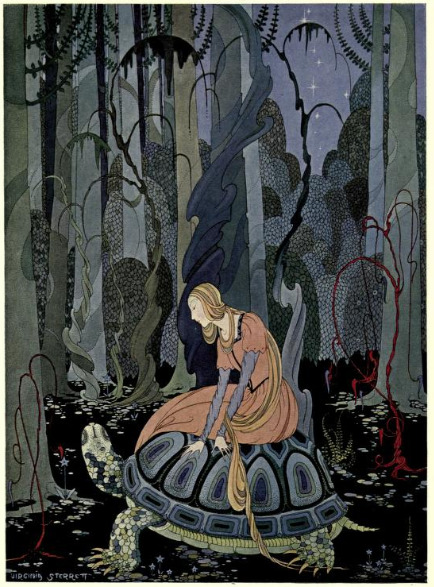
An illustration from a French book of fairy tales written by Sophie Ségur, illustrated by Virginia Frances Sterrett, published in 1920. (More here.)

“Death blowing bubbles,” 18th century plaster on the Holy Grave Chapel in Michaelsberg Abbey, Bamberg, Germany. Apparently I'm not the only one who thinks this would make for a killer tattoo. (More on the abbey here, image via Lindsey Fitzharris.)
7 notes
·
View notes
Text

Recreation of Death Blowing Bubbles, one of the figures in a chapel of the Michaelsberg Abbey in Bamberg. (Original under the cut.)
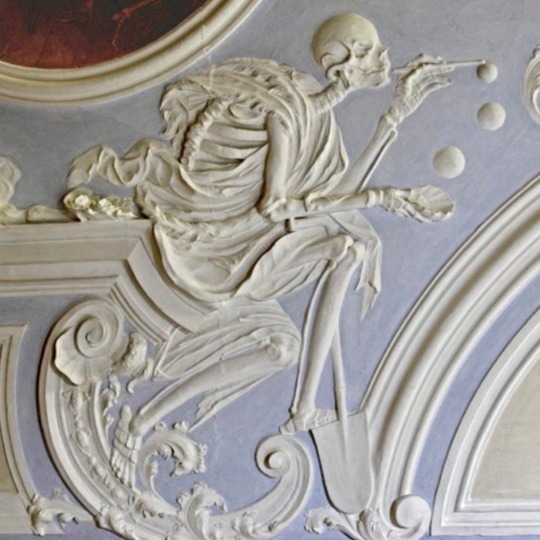
(Source)
#art#dark art#artists on tumblr#trans artist#skeleton#danse macabre#memento mori#catholic art#not actually but the monastery is in fact Catholic#dark aesthetic#my art
36 notes
·
View notes
Photo

“Death blowing bubbles,” is one of the several depictions of death created by Johann Georg Leinberger between 1729 and 1731 for the ceiling of the Holy Grave Chapel in Michaelsberg Abbey in Bamberg, Germany. The bubbles are symbols of the fragility of life.
12 notes
·
View notes
Text







Johann Georg Leinberger decorated the Michaelsberg Abbey, located in Bamberg, Germany from from 1729 to 1731. His art has remained intact despite war, the chapel becoming a hospital in 1803, and structural insecurity. Today it is a UNESCO world heritage site.
#aesthetic#death#beauty#skeleton#art#German#18th century#vibe#gothic#pastel#life#punk#existentialism#rococo#history#style
2 notes
·
View notes
Text


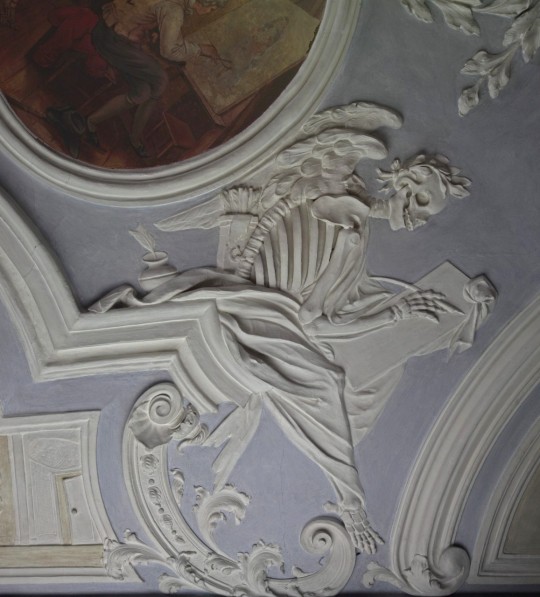
"Death blowing bubbles", 19th century.
Plaster art from the ceiling of the Chapel of the Holy Tomb in Michaelsberg Abbey, Bamberg, Germany. Bubbles symbolize the fragility of life.
6 notes
·
View notes
Text
ceiling of the Holy Grave Chapel in Michaelsberg Abbey, Bamberg in Germany.
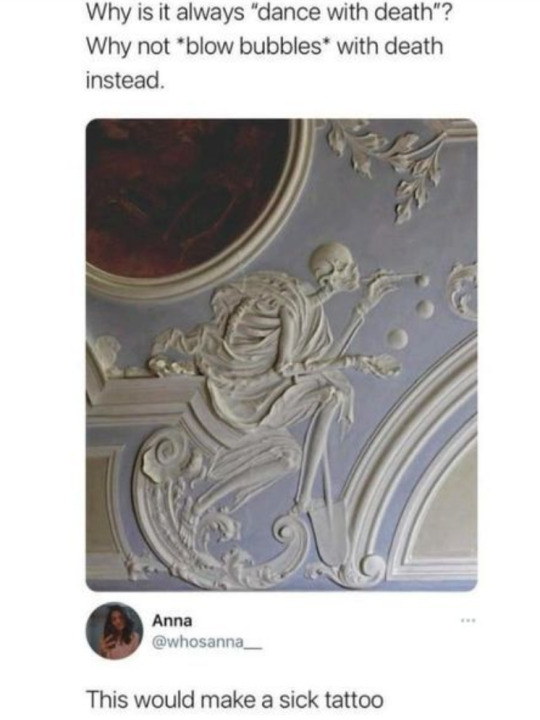
64K notes
·
View notes
Text

“Death blowing bubbles,” one of the several depictions of death created by Johann Georg Leinberger between 1729 and 1731 for the ceiling of the Holy Grave Chapel in Michaelsberg Abbey in Bamberg, Germany. The bubbles are symbols of the fragility of life
0 notes
Text
SAINT OF THE DAY (July 2)

On July 2, the Church celebrates the life and work of St. Otto.
He was born in 1060 in Swabia and died on 30 June 1139.
He was the Bishop of Bamberg, an indefatigable evangelizer, and the apostle of the Pomeranians.
He was born of noble rank and ordained a priest sometime before the age of 30.
He joined the service of Emperor Henry IV in 1090 and became his chancellor in 1101.
He served Henry IV and his successor, Henry V, loyally. However, he disapproved of the latter’s disgraceful treatment of Pope Paschal.
Otto was consecrated a bishop on 13 May 1106.
He set to work founding new monasteries, reforming existing ones, building schools and churches, and completing the construction of the cathedral.
He lived a poor and simple life. He was called the “Father of the Monks” for the concern he showed toward religious orders.
In 1122, Otto was commissioned by the Polish duke, Boleslaw III, to convert Pomerania to Christianity.
He set about this mission in 1124. He traveled across Pomerania twice.
He won over the people with his holiness, quiet generosity and inspiring sermons.
The conversion of Pomerania was his greatest apostolic work.
He baptized over 22,000 people and established 11 churches.
Many miracles were attributed to him throughout his two journeys and many more after his death.
He was buried in Michaelsberg Abbey, Bamberg. He was canonized by Pope Clement III in 1189.
Otto is the patron saint of the Archdiocese of Bamberg and co-patron of the Archdiocese of Berlin and Diocese of Stettin-Kammin.
He is also invoked for help against fever and rabies.
0 notes
Text

“Death blowing bubbles,” one of the several depictions of death created by Johann Georg Leinberger between 1729 and 1731 for the ceiling of the Holy Grave Chapel in Michaelsberg Abbey in Bamberg, Germany.
* * * *
“It is the mynd, that maketh good or ill, That maketh wretch or happie.”
—Edmund Spenser
5 notes
·
View notes